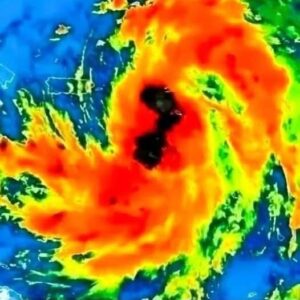On February 17, 2025, Delta Air Lines Flight 4819, operated by Endeavor Air, crashed while
attempting to land at Toronto Pearson International Airport. The aircraft, a Bombardier
CRJ-900, had taken off from Minneapolis–Saint Paul International Airport with 76 passengers
and four crew members on board. The flight was scheduled to arrive in Toronto without any
issues, but what was expected to be a routine landing turned into a terrifying ordeal.
At approximately 2:15 p.m. local time, as the plane descended toward the runway, something
went terribly wrong. Witnesses on the ground and passengers on nearby flights reported
seeing the aircraft veering off course as it touched down. Within moments, the plane flipped
upside down, sliding along the snowy runway before coming to a standstill. Emergency crews
rushed to the site, their vehicles speeding across the tarmac as thick smoke billowed from the overturned fuselage.
Despite the severity of the accident, all 80 individuals on board survived. However, 18 people
were transported to nearby hospitals with injuries, three of whom were reported to be in
critical but non-life-threatening condition. Among the critically injured were a man in his 60s,
a woman in her 40s, and a young child. Paramedics and first responders worked quickly to
assess the wounded, stabilizing those who needed immediate attention before rushing them to medical facilities.
Deborah Flint, CEO of Toronto Pearson International Airport, issued a statement in the evening
expressing relief that the crash had not resulted in any fatalities. She acknowledged the heroic
efforts of emergency responders, airport personnel, and flight crew members who helped evacuate
passengers safely. She described the incident as a close call, noting that it could have been far worse under different circumstances.
Delta Air Lines also released a statement via social media and its official website, confirming
that there were no fatalities and that their primary focus was on taking care of those affected.
The airline assured passengers, families, and the public that they were cooperating
fully with investigators to determine what caused the accident.
Shortly after the crash, CNN obtained and released audio from air traffic control communications
that revealed the intensity of the situation as it unfolded. In the recording, a controller
was heard alerting a medevac aircraft about the presence of people outside the crashed plane,
indicating that passengers had already begun evacuating onto the icy runway. The pilot
of the medevac flight confirmed that they had visual contact with the wreckage,
describing the scene as horrifying, with the aircraft fully upside down and showing signs of fire damage.
Passengers onboard Flight 4819 wasted no time in sharing their firsthand experiences
on social media. One individual, identified as Ashley Zook, recorded and posted a video
immediately after escaping the overturned aircraft. In the footage, she could be seen inside
the jet, visibly shaken and disoriented. Her voice trembled as she described what had happened,
at one point simply stating, “My plane crashed. I’m upside down.” She then let out an expletive, capturing the raw emotion of the moment.
Medical transport company Ornge later confirmed details about the critically injured
passengers and their conditions, though their identities had yet to be publicly released.
While most injuries sustained in the crash were minor, the critical cases highlighted the
severity of the impact and the potential danger that passengers had narrowly escaped.
The Transportation Safety Board of Canada, along with U.S. aviation authorities, immediately
launched an investigation to determine the cause of the accident. Preliminary theories
suggested that adverse weather conditions may have played a role. Heavy snowfall over the
weekend had left the runway slick with ice, and pilots attempting to land in similar conditions
earlier in the day had reported significant challenges. However, officials cautioned that it was too early to make definitive conclusions, and they were committed to conducting a thorough analysis of the flight data recorder, cockpit voice recordings, and aircraft maintenance history.
The incident at Toronto Pearson was particularly alarming given recent aviation accidents in North America. Just weeks earlier, a catastrophic collision near Reagan National Airport in Washington, D.C., had resulted in the deaths of 67 people. That accident, which involved a passenger jet colliding with a Black Hawk helicopter on January 29, was the worst U.S. aviation disaster since 2001. In light of these events, aviation safety concerns had become a renewed topic of discussion among industry professionals and government officials.
As investigators continued their work, passengers and crew members of Flight 4819 recounted their experiences to the media. Many described the chaos of the moments immediately after impact. One passenger, still visibly shaken, recalled the eerie silence right before the plane flipped, followed by screams and the terrifying sensation of weightlessness as the aircraft turned over. Others recounted how they scrambled to unbuckle their seatbelts while suspended upside down, struggling to find an exit.
Flight attendants onboard the plane were praised for their quick thinking and professionalism. Despite the shock of the crash, they remained calm and instructed passengers to evacuate in an orderly manner. One flight attendant reportedly helped guide several injured individuals out of the cabin before exiting herself. Many survivors credited the crew with helping prevent what could have been an even greater catastrophe.
Toronto Pearson Airport temporarily suspended operations following the crash, leading to delays and cancellations of other flights. However, efforts to clear the wreckage and inspect the runway proceeded swiftly, and by 5 p.m., some departures and arrivals had resumed. Meanwhile, family members of passengers anxiously waited for updates, relieved to learn that their loved ones had survived but still desperate for details about their conditions.
Delta Air Lines promised to assist affected passengers, offering compensation, accommodations, and counseling services to those who needed them. CEO Ed Bastian personally addressed the incident, expressing gratitude for the emergency responders and reaffirming the airline’s commitment to safety. He acknowledged that while the situation had been traumatic, the most important outcome was that everyone had made it out alive.





